Abstract
Nongenotoxic carcinogens are chemicals that induce neoplasia without it or its metabolites reacting directly with DNA. Chemicals classified as nongenotoxic carcinogens have been assumed to act as tumor promoters and exhibit threshold tumor dose-responses. This is in contrast to genotoxic carcinogens that are DNA reactive, act as tumor initiators, and are assumed to exhibit proportional responses at low doses. In this perspective, we examine the basic tenets and utility of this classification for evaluating human cancer risk. Two classes of so-called nongenotoxic chemical carcinogens selected for review include cytotoxic agents that induce regenerative hyperplasia (trihalomethanes and inducers of alpha 2-microglobulin nephropathy) and agents that act via receptor-mediated mechanisms (peroxisome proliferators and dioxin). Major conclusions of this review include: a) many chemicals considered to be nongenotoxic carcinogens actually possess certain genotoxic activities, and limiting evaluations of carcinogenicity to their nongenotoxic effects can be misleading; b) some nongenotoxic activities may cause oxidative DNA damage and thereby initiate carcinogenesis; c) although cell replication is involved in tumor development, cytotoxicity and mitogenesis do not reliably predict carcinogenesis; d) a threshold tumor response is not an inevitable result of a receptor-mediated mechanism. There are insufficient data on the chemicals reviewed here to justify treating their carcinogenic effects in animals as irrelevant for evaluating human risk. Research findings that characterize the multiple mechanisms of chemical carcinogenesis should be used quantitatively to clarify human dose-response relationships, leading to improved scientifically based public health decisions. Excessive reliance on oversimplified classification schemes that do not consider all potential contributing effects of a toxicant can obscure the actual causal relationships between exposure and cancer outcome.
Full text
PDF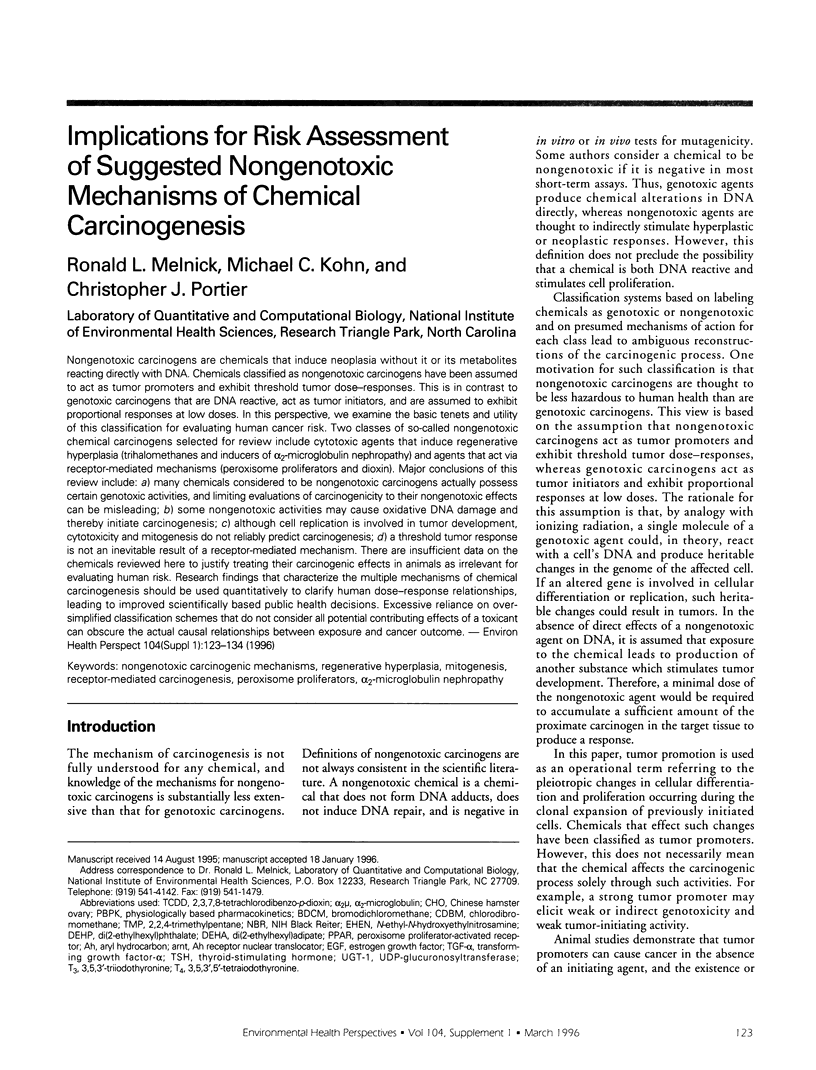

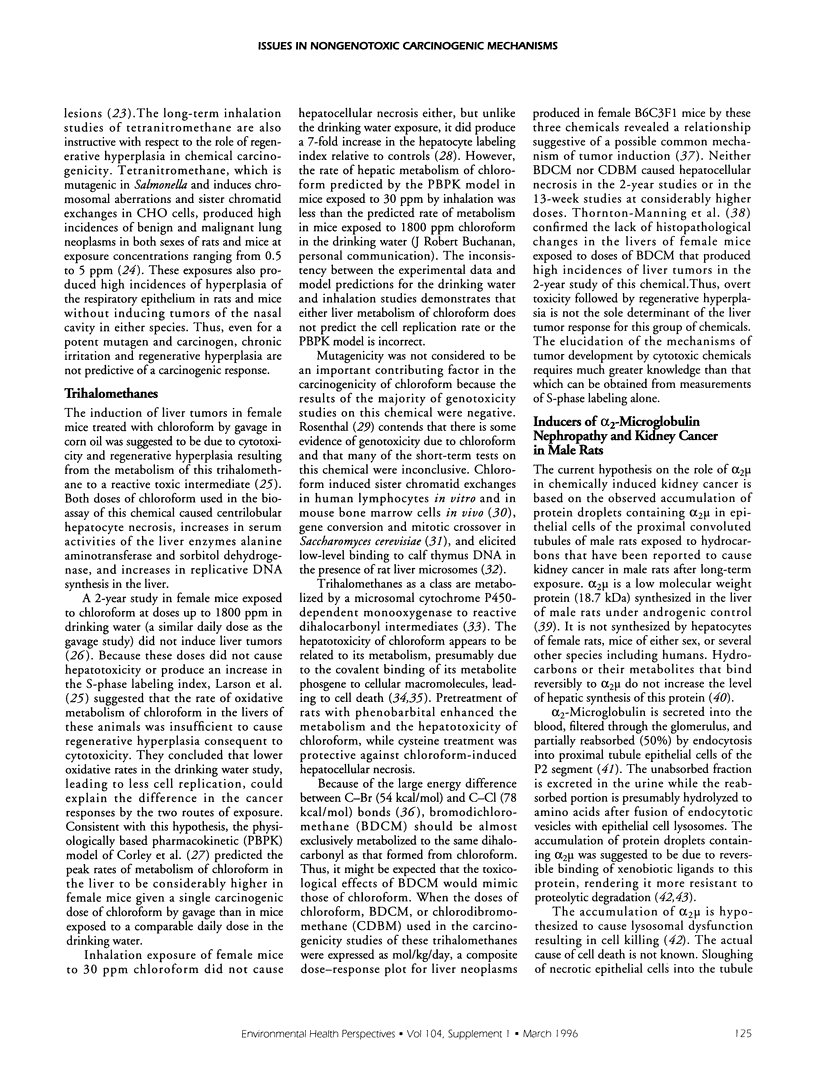


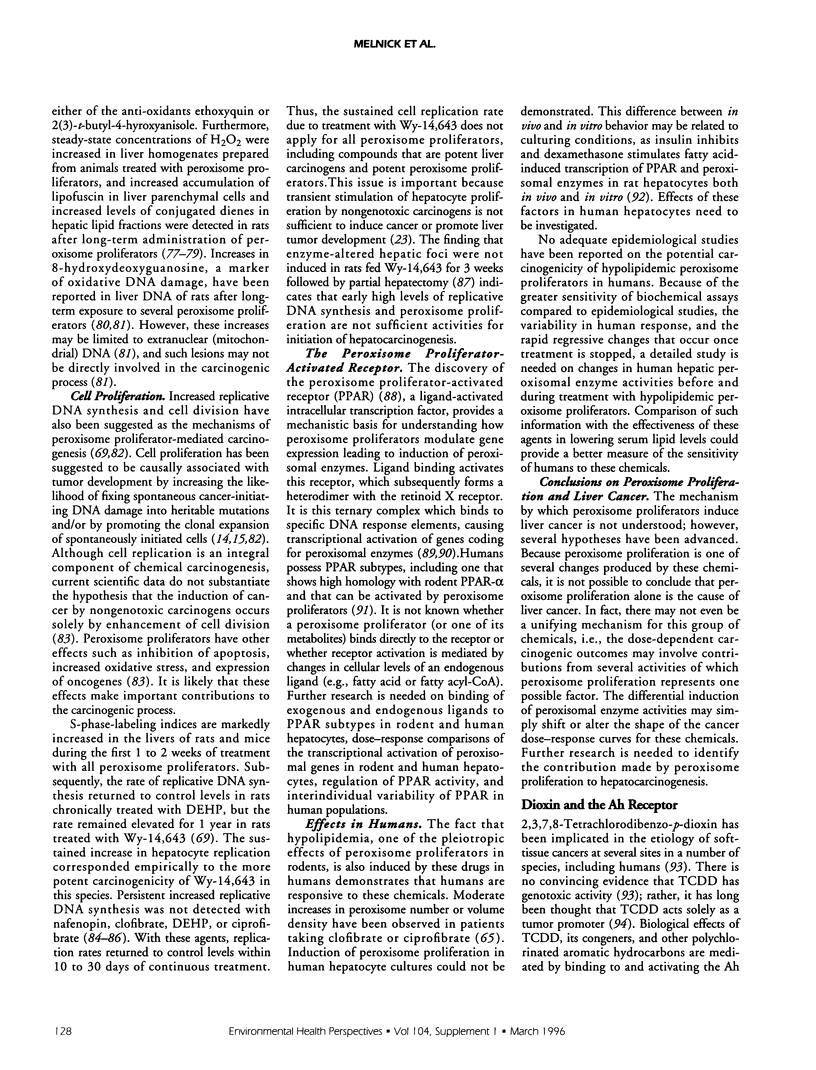
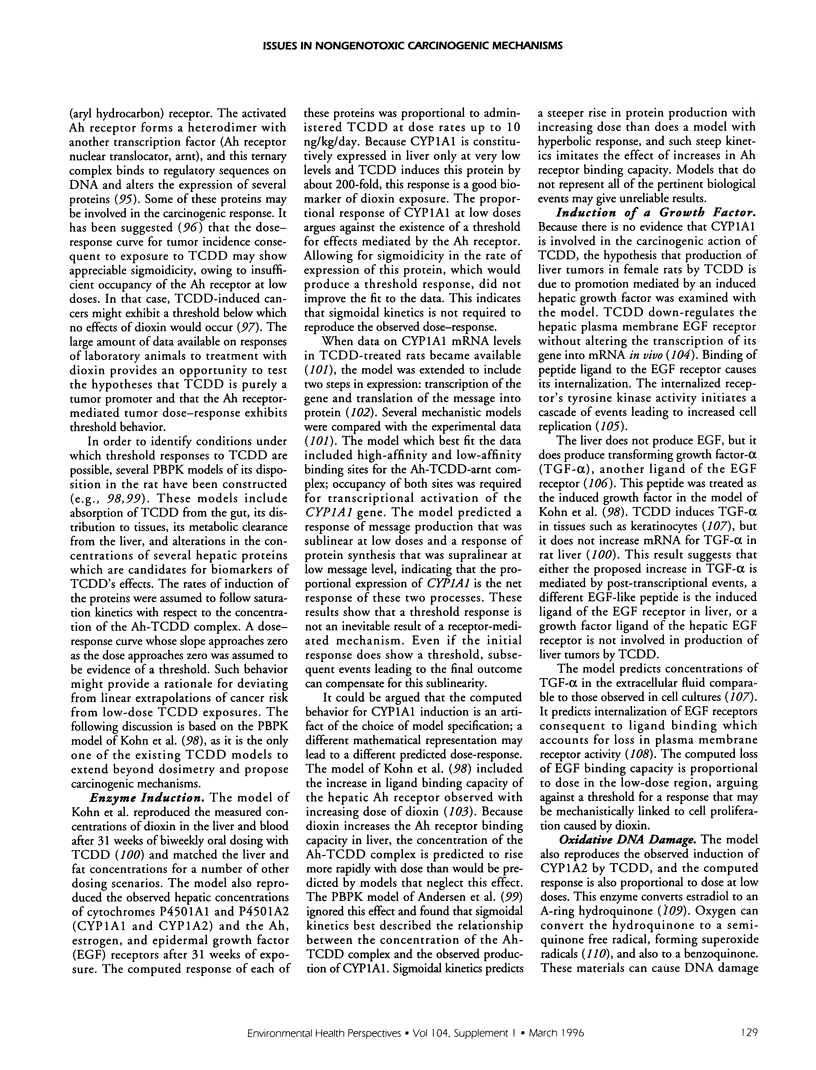



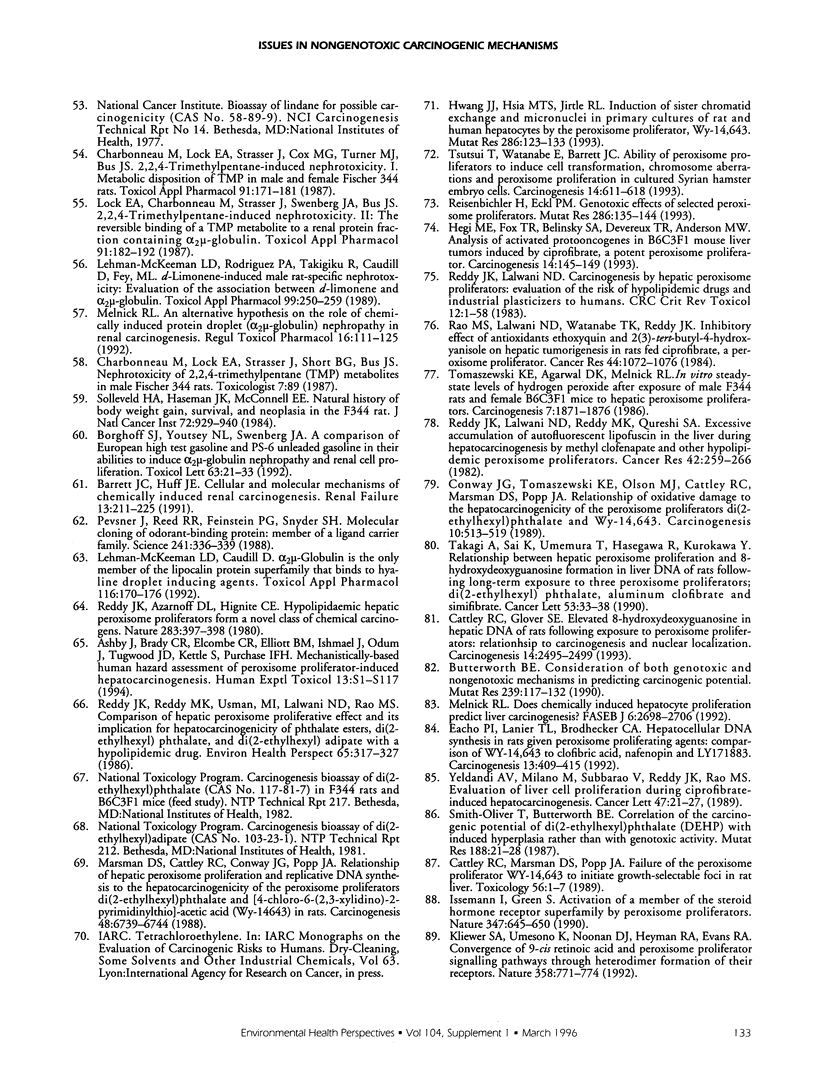

Selected References
These references are in PubMed. This may not be the complete list of references from this article.
- Ahmed A. E., Kubic V. L., Anders M. W. Metabolism of haloforms to carbon monoxide. I. In vitro studies. Drug Metab Dispos. 1977 Mar-Apr;5(2):198–204. [PubMed] [Google Scholar]
- Ames B. N., Gold L. S. Too many rodent carcinogens: mitogenesis increases mutagenesis. Science. 1990 Aug 31;249(4972):970–971. doi: 10.1126/science.2136249. [DOI] [PubMed] [Google Scholar]
- Andersen M. E., Mills J. J., Gargas M. L., Kedderis L., Birnbaum L. S., Neubert D., Greenlee W. F. Modeling receptor-mediated processes with dioxin: implications for pharmacokinetics and risk assessment. Risk Anal. 1993 Feb;13(1):25–36. doi: 10.1111/j.1539-6924.1993.tb00726.x. [DOI] [PubMed] [Google Scholar]
- Ashby J., Brady A., Elcombe C. R., Elliott B. M., Ishmael J., Odum J., Tugwood J. D., Kettle S., Purchase I. F. Mechanistically-based human hazard assessment of peroxisome proliferator-induced hepatocarcinogenesis. Hum Exp Toxicol. 1994 Nov;13 (Suppl 2):S1–117. doi: 10.1177/096032719401300201. [DOI] [PubMed] [Google Scholar]
- Bagchi M., Stohs S. J. In vitro induction of reactive oxygen species by 2,3,7,8-tetrachlorodibenzo-p-dioxin, endrin, and lindane in rat peritoneal macrophages, and hepatic mitochondria and microsomes. Free Radic Biol Med. 1993 Jan;14(1):11–18. doi: 10.1016/0891-5849(93)90504-n. [DOI] [PubMed] [Google Scholar]
- Barrett J. C., Huff J. Cellular and molecular mechanisms of chemically induced renal carcinogenesis. Ren Fail. 1991;13(4):211–225. doi: 10.3109/08860229109022157. [DOI] [PubMed] [Google Scholar]
- Barter R. A., Klaassen C. D. UDP-glucuronosyltransferase inducers reduce thyroid hormone levels in rats by an extrathyroidal mechanism. Toxicol Appl Pharmacol. 1992 Mar;113(1):36–42. doi: 10.1016/0041-008x(92)90006-e. [DOI] [PubMed] [Google Scholar]
- Bock K. W. Roles of UDP-glucuronosyltransferases in chemical carcinogenesis. Crit Rev Biochem Mol Biol. 1991;26(2):129–150. doi: 10.3109/10409239109081125. [DOI] [PubMed] [Google Scholar]
- Borghoff S. J., Miller A. B., Bowen J. P., Swenberg J. A. Characteristics of chemical binding to alpha 2u-globulin in vitro--evaluating structure-activity relationships. Toxicol Appl Pharmacol. 1991 Feb;107(2):228–238. doi: 10.1016/0041-008x(91)90205-s. [DOI] [PubMed] [Google Scholar]
- Borghoff S. J., Youtsey N. L., Swenberg J. A. A comparison of European High Test gasoline and PS-6 unleaded gasoline in their abilities to induce alpha 2u-globulin nephropathy and renal cell proliferation. Toxicol Lett. 1992 Oct;63(1):21–33. doi: 10.1016/0378-4274(92)90104-r. [DOI] [PubMed] [Google Scholar]
- Bucher J. R., Huff J. E., Jokinen M. P., Haseman J. K., Stedham M., Cholakis J. M. Inhalation of tetranitromethane causes nasal passage irritation and pulmonary carcinogenesis in rodents. Cancer Lett. 1991 May 1;57(2):95–101. doi: 10.1016/0304-3835(91)90201-r. [DOI] [PubMed] [Google Scholar]
- Butterworth B. E. Consideration of both genotoxic and nongenotoxic mechanisms in predicting carcinogenic potential. Mutat Res. 1990 Sep;239(2):117–132. doi: 10.1016/0165-1110(90)90033-8. [DOI] [PubMed] [Google Scholar]
- Callen D. F., Wolf C. R., Philpot R. M. Cytochrome P-450 mediated genetic activity and cytotoxicity of seven halogenated aliphatic hydrocarbons in Saccharomyces cerevisiae. Mutat Res. 1980 Jan;77(1):55–63. doi: 10.1016/0165-1218(80)90120-2. [DOI] [PubMed] [Google Scholar]
- Cattley R. C., Glover S. E. Elevated 8-hydroxydeoxyguanosine in hepatic DNA of rats following exposure to peroxisome proliferators: relationship to carcinogenesis and nuclear localization. Carcinogenesis. 1993 Dec;14(12):2495–2499. doi: 10.1093/carcin/14.12.2495. [DOI] [PubMed] [Google Scholar]
- Cattley R. C., Marsman D. S., Popp J. A. Failure of the peroxisome proliferator WY-14,643 to initiate growth-selectable foci in rat liver. Toxicology. 1989 May 31;56(1):1–7. doi: 10.1016/0300-483x(89)90207-2. [DOI] [PubMed] [Google Scholar]
- Charbonneau M., Lock E. A., Strasser J., Cox M. G., Turner M. J., Bus J. S. 2,2,4-Trimethylpentane-induced nephrotoxicity. I. Metabolic disposition of TMP in male and female Fischer 344 rats. Toxicol Appl Pharmacol. 1987 Nov;91(2):171–181. doi: 10.1016/0041-008x(87)90098-6. [DOI] [PubMed] [Google Scholar]
- Choi E. J., Toscano D. G., Ryan J. A., Riedel N., Toscano W. A., Jr Dioxin induces transforming growth factor-alpha in human keratinocytes. J Biol Chem. 1991 May 25;266(15):9591–9597. [PubMed] [Google Scholar]
- Cohen S. M., Ellwein L. B. Cell proliferation in carcinogenesis. Science. 1990 Aug 31;249(4972):1007–1011. doi: 10.1126/science.2204108. [DOI] [PubMed] [Google Scholar]
- Conway J. G., Tomaszewski K. E., Olson M. J., Cattley R. C., Marsman D. S., Popp J. A. Relationship of oxidative damage to the hepatocarcinogenicity of the peroxisome proliferators di(2-ethylhexyl)phthalate and Wy-14,643. Carcinogenesis. 1989 Mar;10(3):513–519. doi: 10.1093/carcin/10.3.513. [DOI] [PubMed] [Google Scholar]
- Corley R. A., Mendrala A. L., Smith F. A., Staats D. A., Gargas M. L., Conolly R. B., Andersen M. E., Reitz R. H. Development of a physiologically based pharmacokinetic model for chloroform. Toxicol Appl Pharmacol. 1990 May;103(3):512–527. doi: 10.1016/0041-008x(90)90324-n. [DOI] [PubMed] [Google Scholar]
- Deml E., Schwarz L. R., Oesterle D. Initiation of enzyme-altered foci by the synthetic steroid cyproterone acetate in rat liver foci bioassay. Carcinogenesis. 1993 Jun;14(6):1229–1231. doi: 10.1093/carcin/14.6.1229. [DOI] [PubMed] [Google Scholar]
- DiRenzo A. B., Gandolfi A. J., Sipes I. G. Microsomal bioactivation and covalent binding of aliphatic halides to DNA. Toxicol Lett. 1982 May;11(3-4):243–252. doi: 10.1016/0378-4274(82)90157-6. [DOI] [PubMed] [Google Scholar]
- Dietrich D. R., Swenberg J. A. Lindane induces nephropathy and renal accumulation of alpha 2u-globulin in male but not in female Fischer 344 rats or male NBR rats. Toxicol Lett. 1990 Sep;53(1-2):179–181. doi: 10.1016/0378-4274(90)90120-b. [DOI] [PubMed] [Google Scholar]
- Dietrich D. R., Swenberg J. A. NCI-Black-Reiter (NBR) male rats fail to develop renal disease following exposure to agents that induce alpha-2u-globulin (alpha 2u) nephropathy. Fundam Appl Toxicol. 1991 May;16(4):749–762. doi: 10.1016/0272-0590(91)90161-v. [DOI] [PubMed] [Google Scholar]
- Dietrich D. R., Swenberg J. A. The presence of alpha 2u-globulin is necessary for d-limonene promotion of male rat kidney tumors. Cancer Res. 1991 Jul 1;51(13):3512–3521. [PubMed] [Google Scholar]
- Docks E. L., Krishna G. The role of glutathione in chloroform-induced hepatotoxicity. Exp Mol Pathol. 1976 Feb;24(1):13–22. doi: 10.1016/0014-4800(76)90053-8. [DOI] [PubMed] [Google Scholar]
- Dominick M. A., Robertson D. G., Bleavins M. R., Sigler R. E., Bobrowski W. F., Gough A. W. Alpha 2u-globulin nephropathy without nephrocarcinogenesis in male Wistar rats administered 1-(aminomethyl)cyclohexaneacetic acid. Toxicol Appl Pharmacol. 1991 Dec;111(3):375–387. doi: 10.1016/0041-008x(91)90244-9. [DOI] [PubMed] [Google Scholar]
- Dunnick J. K., Melnick R. L. Assessment of the carcinogenic potential of chlorinated water: experimental studies of chlorine, chloramine, and trihalomethanes. J Natl Cancer Inst. 1993 May 19;85(10):817–822. doi: 10.1093/jnci/85.10.817. [DOI] [PubMed] [Google Scholar]
- Eldridge S. R., Goldsworthy T. L., Popp J. A., Butterworth B. E. Mitogenic stimulation of hepatocellular proliferation in rodents following 1,4-dichlorobenzene administration. Carcinogenesis. 1992 Mar;13(3):409–415. doi: 10.1093/carcin/13.3.409. [DOI] [PubMed] [Google Scholar]
- Greaves P., Goonetilleke R., Nunn G., Topham J., Orton T. Two-year carcinogenicity study of tamoxifen in Alderley Park Wistar-derived rats. Cancer Res. 1993 Sep 1;53(17):3919–3924. [PubMed] [Google Scholar]
- Halder C. A., Holdsworth C. E., Cockrell B. Y., Piccirillo V. J. Hydrocarbon nephropathy in male rats: identification of the nephrotoxic components of unleaded gasoline. Toxicol Ind Health. 1985 Nov;1(3):67–87. doi: 10.1177/074823378500100305. [DOI] [PubMed] [Google Scholar]
- Han X. L., Liehr J. G. Induction of covalent DNA adducts in rodents by tamoxifen. Cancer Res. 1992 Mar 1;52(5):1360–1363. [PubMed] [Google Scholar]
- Hegi M. E., Fox T. R., Belinsky S. A., Devereux T. R., Anderson M. W. Analysis of activated protooncogenes in B6C3F1 mouse liver tumors induced by ciprofibrate, a potent peroxisome proliferator. Carcinogenesis. 1993 Jan;14(1):145–149. doi: 10.1093/carcin/14.1.145. [DOI] [PubMed] [Google Scholar]
- Huff J. E., Salmon A. G., Hooper N. K., Zeise L. Long-term carcinogenesis studies on 2,3,7,8-tetrachlorodibenzo-p-dioxin and hexachlorodibenzo-p-dioxins. Cell Biol Toxicol. 1991 Jan;7(1):67–94. doi: 10.1007/BF00121331. [DOI] [PubMed] [Google Scholar]
- Hwang J. J., Hsia M. T., Jirtle R. L. Induction of sister chromatid exchange and micronuclei in primary cultures of rat and human hepatocytes by the peroxisome proliferator, Wy-14,643. Mutat Res. 1993 Apr;286(2):123–133. doi: 10.1016/0027-5107(93)90176-g. [DOI] [PubMed] [Google Scholar]
- Issemann I., Green S. Activation of a member of the steroid hormone receptor superfamily by peroxisome proliferators. Nature. 1990 Oct 18;347(6294):645–650. doi: 10.1038/347645a0. [DOI] [PubMed] [Google Scholar]
- Issemann I., Prince R. A., Tugwood J. D., Green S. The retinoid X receptor enhances the function of the peroxisome proliferator activated receptor. Biochimie. 1993;75(3-4):251–256. doi: 10.1016/0300-9084(93)90084-6. [DOI] [PubMed] [Google Scholar]
- Johnson E. F. A partnership between the dioxin receptor and a basic helix-loop-helix protein. Science. 1991 May 17;252(5008):924–925. doi: 10.1126/science.1852074. [DOI] [PubMed] [Google Scholar]
- Jorgenson T. A., Meierhenry E. F., Rushbrook C. J., Bull R. J., Robinson M. Carcinogenicity of chloroform in drinking water to male Osborne-Mendel rats and female B6C3F1 mice. Fundam Appl Toxicol. 1985 Aug;5(4):760–769. doi: 10.1016/0272-0590(85)90200-3. [DOI] [PubMed] [Google Scholar]
- Kliewer S. A., Umesono K., Noonan D. J., Heyman R. A., Evans R. M. Convergence of 9-cis retinoic acid and peroxisome proliferator signalling pathways through heterodimer formation of their receptors. Nature. 1992 Aug 27;358(6389):771–774. doi: 10.1038/358771a0. [DOI] [PMC free article] [PubMed] [Google Scholar]
- Kohn M. C., Lucier G. W., Clark G. C., Sewall C., Tritscher A. M., Portier C. J. A mechanistic model of effects of dioxin on gene expression in the rat liver. Toxicol Appl Pharmacol. 1993 May;120(1):138–154. doi: 10.1006/taap.1993.1096. [DOI] [PubMed] [Google Scholar]
- Kohn M. C., Lucier G. W., Portier C. J. The importance of biological realism in dioxin risk assessment models. Risk Anal. 1994 Dec;14(6):993–1000. doi: 10.1111/j.1539-6924.1994.tb00068.x. [DOI] [PubMed] [Google Scholar]
- Kohn M. C., Portier C. J. Effects of the mechanism of receptor-mediated gene expression on the shape of the dose-response curve. Risk Anal. 1993 Oct;13(5):565–572. doi: 10.1111/j.1539-6924.1993.tb00016.x. [DOI] [PubMed] [Google Scholar]
- Larson J. L., Wolf D. C., Butterworth B. E. Induced cytotoxicity and cell proliferation in the hepatocarcinogenicity of chloroform in female B6C3F1 mice: comparison of administration by gavage in corn oil vs ad libitum in drinking water. Fundam Appl Toxicol. 1994 Jan;22(1):90–102. doi: 10.1006/faat.1994.1012. [DOI] [PubMed] [Google Scholar]
- Larson J. L., Wolf D. C., Morgan K. T., Méry S., Butterworth B. E. The toxicity of 1-week exposures to inhaled chloroform in female B6C3F1 mice and male F-344 rats. Fundam Appl Toxicol. 1994 Apr;22(3):431–446. doi: 10.1006/faat.1994.1049. [DOI] [PubMed] [Google Scholar]
- Lehman-McKeeman L. D., Caudill D. Alpha 2u-globulin is the only member of the lipocalin protein superfamily that binds to hyaline droplet inducing agents. Toxicol Appl Pharmacol. 1992 Oct;116(2):170–176. doi: 10.1016/0041-008x(92)90296-5. [DOI] [PubMed] [Google Scholar]
- Lehman-McKeeman L. D., Rivera-Torres M. I., Caudill D. Lysosomal degradation of alpha 2u-globulin and alpha 2u-globulin-xenobiotic conjugates. Toxicol Appl Pharmacol. 1990 May;103(3):539–548. doi: 10.1016/0041-008x(90)90326-p. [DOI] [PubMed] [Google Scholar]
- Lehman-McKeeman L. D., Rodriguez P. A., Takigiku R., Caudill D., Fey M. L. d-Limonene-induced male rat-specific nephrotoxicity: evaluation of the association between d-limonene and alpha 2u-globulin. Toxicol Appl Pharmacol. 1989 Jun 15;99(2):250–259. doi: 10.1016/0041-008x(89)90007-0. [DOI] [PubMed] [Google Scholar]
- Li S. A., Klicka J. K., Li J. J. Estrogen 2- and 4-hydroxylase activity, catechol estrogen formation, and implications for estrogen carcinogenesis in the hamster kidney. Cancer Res. 1985 Jan;45(1):181–185. [PubMed] [Google Scholar]
- Lin F. H., Clark G., Birnbaum L. S., Lucier G. W., Goldstein J. A. Influence of the Ah locus on the effects of 2,3,7,8-tetrachlorodibenzo-p-dioxin on the hepatic epidermal growth factor receptor. Mol Pharmacol. 1991 Mar;39(3):307–313. [PubMed] [Google Scholar]
- Lock E. A., Charbonneau M., Strasser J., Swenberg J. A., Bus J. S. 2,2,4-Trimethylpentane-induced nephrotoxicity. II. The reversible binding of a TMP metabolite to a renal protein fraction containing alpha 2u-globulin. Toxicol Appl Pharmacol. 1987 Nov;91(2):182–192. doi: 10.1016/0041-008x(87)90099-8. [DOI] [PubMed] [Google Scholar]
- Marsman D. S., Cattley R. C., Conway J. G., Popp J. A. Relationship of hepatic peroxisome proliferation and replicative DNA synthesis to the hepatocarcinogenicity of the peroxisome proliferators di(2-ethylhexyl)phthalate and [4-chloro-6-(2,3-xylidino)-2-pyrimidinylthio]acetic acid (Wy-14,643) in rats. Cancer Res. 1988 Dec 1;48(23):6739–6744. [PubMed] [Google Scholar]
- Mead J. E., Fausto N. Transforming growth factor alpha may be a physiological regulator of liver regeneration by means of an autocrine mechanism. Proc Natl Acad Sci U S A. 1989 Mar;86(5):1558–1562. doi: 10.1073/pnas.86.5.1558. [DOI] [PMC free article] [PubMed] [Google Scholar]
- Melnick R. L. An alternative hypothesis on the role of chemically induced protein droplet (alpha 2u-globulin) nephropathy in renal carcinogenesis. Regul Toxicol Pharmacol. 1992 Oct;16(2):111–125. doi: 10.1016/0273-2300(92)90052-b. [DOI] [PubMed] [Google Scholar]
- Melnick R. L. Does chemically induced hepatocyte proliferation predict liver carcinogenesis? FASEB J. 1992 Jun;6(9):2698–2706. doi: 10.1096/fasebj.6.9.1612294. [DOI] [PubMed] [Google Scholar]
- Melnick R. L., Huff J., Barrett J. C., Maronpot R. R., Lucier G., Portier C. J. Cell proliferation and chemical carcinogenesis: symposium overview. Environ Health Perspect. 1993 Dec;101 (Suppl 5):3–7. doi: 10.1289/ehp.93101s53. [DOI] [PMC free article] [PubMed] [Google Scholar]
- Melnick R. L., Huff J. Liver carcinogenesis is not a predicted outcome of chemically induced hepatocyte proliferation. Toxicol Ind Health. 1993 May-Jun;9(3):415–438. doi: 10.1177/074823379300900303. [DOI] [PubMed] [Google Scholar]
- Morimoto K., Koizumi A. Trihalomethanes induce sister chromatid exchanges in human lymphocytes in vitro and mouse bone marrow cells in vivo. Environ Res. 1983 Oct;32(1):72–79. doi: 10.1016/0013-9351(83)90193-7. [DOI] [PubMed] [Google Scholar]
- Neuhaus O. W., Flory W., Biswas N., Hollerman C. E. Urinary excretion of alpha 2 mu-globulin and albumin by adult male rats following treatment with nephrotoxic agents. Nephron. 1981;28(3):133–140. doi: 10.1159/000182134. [DOI] [PubMed] [Google Scholar]
- Neumann I., Thierau D., Andrae U., Greim H., Schwarz L. R. Cyproterone acetate induces DNA damage in cultured rat hepatocytes and preferentially stimulates DNA synthesis in gamma-glutamyltranspeptidase-positive cells. Carcinogenesis. 1992 Mar;13(3):373–378. doi: 10.1093/carcin/13.3.373. [DOI] [PubMed] [Google Scholar]
- Olson M. J., Garg B. D., Murty C. V., Roy A. K. Accumulation of alpha 2u-globulin in the renal proximal tubules of male rats exposed to unleaded gasoline. Toxicol Appl Pharmacol. 1987 Aug;90(1):43–51. doi: 10.1016/0041-008x(87)90304-8. [DOI] [PubMed] [Google Scholar]
- Pathak D. N., Bodell W. J. DNA adduct formation by tamoxifen with rat and human liver microsomal activation systems. Carcinogenesis. 1994 Mar;15(3):529–532. doi: 10.1093/carcin/15.3.529. [DOI] [PubMed] [Google Scholar]
- Peraino C., Fry R. J., Staffeldt E., Christopher J. P. Enhancing effects of phenobarbitone and butylated hydroxytoluene on 2-acetylaminofluorene-induced hepatic tumorigenesis in the rat. Food Cosmet Toxicol. 1977 Apr;15(2):93–96. doi: 10.1016/s0015-6264(77)80311-8. [DOI] [PubMed] [Google Scholar]
- Peraino C., Fry R. J., Staffeldt E., Kisieleski W. E. Effects of varying the exposure to phenobarbital on its enhancement of 2-acetylaminofluorene-induced hepatic tumorigenesis in the rat. Cancer Res. 1973 Nov;33(11):2701–2705. [PubMed] [Google Scholar]
- Perera F. P. Perspectives on the risk assessment for nongenotoxic carcinogens and tumor promoters. Environ Health Perspect. 1991 Aug;94:231–235. doi: 10.1289/ehp.94-1567969. [DOI] [PMC free article] [PubMed] [Google Scholar]
- Pevsner J., Reed R. R., Feinstein P. G., Snyder S. H. Molecular cloning of odorant-binding protein: member of a ligand carrier family. Science. 1988 Jul 15;241(4863):336–339. doi: 10.1126/science.3388043. [DOI] [PubMed] [Google Scholar]
- Poland A., Knutson J. C. 2,3,7,8-tetrachlorodibenzo-p-dioxin and related halogenated aromatic hydrocarbons: examination of the mechanism of toxicity. Annu Rev Pharmacol Toxicol. 1982;22:517–554. doi: 10.1146/annurev.pa.22.040182.002505. [DOI] [PubMed] [Google Scholar]
- Portier C., Tritscher A., Kohn M., Sewall C., Clark G., Edler L., Hoel D., Lucier G. Ligand/receptor binding for 2,3,7,8-TCDD: implications for risk assessment. Fundam Appl Toxicol. 1993 Jan;20(1):48–56. doi: 10.1006/faat.1993.1006. [DOI] [PubMed] [Google Scholar]
- Randerath K., Moorthy B., Mabon N., Sriram P. Tamoxifen: evidence by 32P-postlabeling and use of metabolic inhibitors for two distinct pathways leading to mouse hepatic DNA adduct formation and identification of 4-hydroxytamoxifen as a proximate metabolite. Carcinogenesis. 1994 Oct;15(10):2087–2094. doi: 10.1093/carcin/15.10.2087. [DOI] [PubMed] [Google Scholar]
- Rao M. S., Lalwani N. D., Watanabe T. K., Reddy J. K. Inhibitory effect of antioxidants ethoxyquin and 2(3)-tert-butyl-4-hydroxyanisole on hepatic tumorigenesis in rats fed ciprofibrate, a peroxisome proliferator. Cancer Res. 1984 Mar;44(3):1072–1076. [PubMed] [Google Scholar]
- Reddy J. K., Azarnoff D. L., Hignite C. E. Hypolipidaemic hepatic peroxisome proliferators form a novel class of chemical carcinogens. Nature. 1980 Jan 24;283(5745):397–398. doi: 10.1038/283397a0. [DOI] [PubMed] [Google Scholar]
- Reddy J. K., Lalwai N. D. Carcinogenesis by hepatic peroxisome proliferators: evaluation of the risk of hypolipidemic drugs and industrial plasticizers to humans. Crit Rev Toxicol. 1983;12(1):1–58. doi: 10.3109/10408448309029317. [DOI] [PubMed] [Google Scholar]
- Reddy J. K., Lalwani N. D., Reddy M. K., Qureshi S. A. Excessive accumulation of autofluorescent lipofuscin in the liver during hepatocarcinogenesis by methyl clofenapate and other hypolipidemic peroxisome proliferators. Cancer Res. 1982 Jan;42(1):259–266. [PubMed] [Google Scholar]
- Reddy J. K., Reddy M. K., Usman M. I., Lalwani N. D., Rao M. S. Comparison of hepatic peroxisome proliferative effect and its implication for hepatocarcinogenicity of phthalate esters, di(2-ethylhexyl) phthalate, and di(2-ethylhexyl) adipate with a hypolipidemic drug. Environ Health Perspect. 1986 Mar;65:317–327. doi: 10.1289/ehp.8665317. [DOI] [PMC free article] [PubMed] [Google Scholar]
- Reisenbichler H., Eckl P. M. Genotoxic effects of selected peroxisome proliferators. Mutat Res. 1993 Apr;286(2):135–144. doi: 10.1016/0027-5107(93)90177-h. [DOI] [PubMed] [Google Scholar]
- Roberts L. Dioxin risks revisited. Science. 1991 Feb 8;251(4994):624–626. doi: 10.1126/science.1846976. [DOI] [PubMed] [Google Scholar]
- Rosenthal S. L. A review of the mutagenicity of chloroform. Environ Mol Mutagen. 1987;10(2):211–226. doi: 10.1002/em.2850100212. [DOI] [PubMed] [Google Scholar]
- Roy A. K., Neuhaus O. W. Androgenic control of a sex-dependent protein in the rat. Nature. 1967 May 6;214(5088):618–620. doi: 10.1038/214618b0. [DOI] [PubMed] [Google Scholar]
- Saito K., Kaneko H., Sato K., Yoshitake A., Yamada H. Hepatic UDP-glucuronyltransferase(s) activity toward thyroid hormones in rats: induction and effects on serum thyroid hormone levels following treatment with various enzyme inducers. Toxicol Appl Pharmacol. 1991 Oct;111(1):99–106. doi: 10.1016/0041-008x(91)90138-5. [DOI] [PubMed] [Google Scholar]
- Schlessinger J., Schreiber A. B., Levi A., Lax I., Libermann T., Yarden Y. Regulation of cell proliferation by epidermal growth factor. CRC Crit Rev Biochem. 1983;14(2):93–111. doi: 10.3109/10409238309102791. [DOI] [PubMed] [Google Scholar]
- Schulte-Hermann R., Timmermann-Trosiener I., Schuppler J. Promotion of spontaneous preneoplastic cells in rat liver as a possible explanation of tumor production by nonmutagenic compounds. Cancer Res. 1983 Feb;43(2):839–844. [PubMed] [Google Scholar]
- Sewall C. H., Flagler N., Vanden Heuvel J. P., Clark G. C., Tritscher A. M., Maronpot R. M., Lucier G. W. Alterations in thyroid function in female Sprague-Dawley rats following chronic treatment with 2,3,7,8-tetrachlorodibenzo-p-dioxin. Toxicol Appl Pharmacol. 1995 Jun;132(2):237–244. doi: 10.1006/taap.1995.1104. [DOI] [PubMed] [Google Scholar]
- Sewall C. H., Lucier G. W., Tritscher A. M., Clark G. C. TCDD-mediated changes in hepatic epidermal growth factor receptor may be a critical event in the hepatocarcinogenic action of TCDD. Carcinogenesis. 1993 Sep;14(9):1885–1893. doi: 10.1093/carcin/14.9.1885. [DOI] [PubMed] [Google Scholar]
- Sher T., Yi H. F., McBride O. W., Gonzalez F. J. cDNA cloning, chromosomal mapping, and functional characterization of the human peroxisome proliferator activated receptor. Biochemistry. 1993 Jun 1;32(21):5598–5604. doi: 10.1021/bi00072a015. [DOI] [PubMed] [Google Scholar]
- Short B. G., Burnett V. L., Cox M. G., Bus J. S., Swenberg J. A. Site-specific renal cytotoxicity and cell proliferation in male rats exposed to petroleum hydrocarbons. Lab Invest. 1987 Nov;57(5):564–577. [PubMed] [Google Scholar]
- Short B. G., Burnett V. L., Swenberg J. A. Elevated proliferation of proximal tubule cells and localization of accumulated alpha 2u-globulin in F344 rats during chronic exposure to unleaded gasoline or 2,2,4-trimethylpentane. Toxicol Appl Pharmacol. 1989 Dec;101(3):414–431. doi: 10.1016/0041-008x(89)90191-9. [DOI] [PubMed] [Google Scholar]
- Short B. G., Steinhagen W. H., Swenberg J. A. Promoting effects of unleaded gasoline and 2,2,4-trimethylpentane on the development of atypical cell foci and renal tubular cell tumors in rats exposed to N-ethyl-N-hydroxyethylnitrosamine. Cancer Res. 1989 Nov 15;49(22):6369–6378. [PubMed] [Google Scholar]
- Sloop T. C., Lucier G. W. Dose-dependent elevation of Ah receptor binding by TCDD in rat liver. Toxicol Appl Pharmacol. 1987 May;88(3):329–337. doi: 10.1016/0041-008x(87)90208-0. [DOI] [PubMed] [Google Scholar]
- Smith-Oliver T., Butterworth B. E. Correlation of the carcinogenic potential of di(2-ethylhexyl)phthalate (DEHP) with induced hyperplasia rather than with genotoxic activity. Mutat Res. 1987 May;188(1):21–28. doi: 10.1016/0165-1218(87)90110-8. [DOI] [PubMed] [Google Scholar]
- Solleveld H. A., Haseman J. K., McConnell E. E. Natural history of body weight gain, survival, and neoplasia in the F344 rat. J Natl Cancer Inst. 1984 Apr;72(4):929–940. [PubMed] [Google Scholar]
- Steineger H. H., Sørensen H. N., Tugwood J. D., Skrede S., Spydevold O., Gautvik K. M. Dexamethasone and insulin demonstrate marked and opposite regulation of the steady-state mRNA level of the peroxisomal proliferator-activated receptor (PPAR) in hepatic cells. Hormonal modulation of fatty-acid-induced transcription. Eur J Biochem. 1994 Nov 1;225(3):967–974. doi: 10.1111/j.1432-1033.1994.0967b.x. [DOI] [PubMed] [Google Scholar]
- Stott W. T., Reitz R. H., Schumann A. M., Watanabe P. G. Genetic and nongenetic events in neoplasia. Food Cosmet Toxicol. 1981 Oct;19(5):567–576. doi: 10.1016/0015-6264(81)90507-1. [DOI] [PubMed] [Google Scholar]
- Styles J. A., Davies A., Lim C. K., De Matteis F., Stanley L. A., White I. N., Yuan Z. X., Smith L. L. Genotoxicity of tamoxifen, tamoxifen epoxide and toremifene in human lymphoblastoid cells containing human cytochrome P450s. Carcinogenesis. 1994 Jan;15(1):5–9. doi: 10.1093/carcin/15.1.5. [DOI] [PubMed] [Google Scholar]
- Swenberg J. A., Short B., Borghoff S., Strasser J., Charbonneau M. The comparative pathobiology of alpha 2u-globulin nephropathy. Toxicol Appl Pharmacol. 1989 Jan;97(1):35–46. doi: 10.1016/0041-008x(89)90053-7. [DOI] [PubMed] [Google Scholar]
- Takagi A., Sai K., Umemura T., Hasegawa R., Kurokawa Y. Relationship between hepatic peroxisome proliferation and 8-hydroxydeoxyguanosine formation in liver DNA of rats following long-term exposure to three peroxisome proliferators; di(2-ethylhexyl) phthalate, aluminium clofibrate and simfibrate. Cancer Lett. 1990 Aug;53(1):33–38. doi: 10.1016/0304-3835(90)90007-k. [DOI] [PubMed] [Google Scholar]
- Thornton-Manning J. R., Seely J. C., Pegram R. A. Toxicity of bromodichloromethane in female rats and mice after repeated oral dosing. Toxicology. 1994 Nov-Dec;94(1-3):3–18. doi: 10.1016/0300-483x(94)90024-8. [DOI] [PubMed] [Google Scholar]
- Tomaszewski K. E., Agarwal D. K., Melnick R. L. In vitro steady-state levels of hydrogen peroxide after exposure of male F344 rats and female B6C3F1 mice to hepatic peroxisome proliferators. Carcinogenesis. 1986 Nov;7(11):1871–1876. doi: 10.1093/carcin/7.11.1871. [DOI] [PubMed] [Google Scholar]
- Tomatis L. Cell proliferation and carcinogenesis: a brief history and current view based on an IARC workshop report. International Agency for Research on Cancer. Environ Health Perspect. 1993 Dec;101 (Suppl 5):149–151. doi: 10.1289/ehp.93101s5149. [DOI] [PMC free article] [PubMed] [Google Scholar]
- Topinka J., Andrae U., Schwarz L. R., Wolff T. Cyproterone acetate generates DNA adducts in rat liver and in primary rat hepatocyte cultures. Carcinogenesis. 1993 Mar;14(3):423–427. doi: 10.1093/carcin/14.3.423. [DOI] [PubMed] [Google Scholar]
- Tritscher A. M., Goldstein J. A., Portier C. J., McCoy Z., Clark G. C., Lucier G. W. Dose-response relationships for chronic exposure to 2,3,7,8-tetrachlorodibenzo-p-dioxin in a rat tumor promotion model: quantification and immunolocalization of CYP1A1 and CYP1A2 in the liver. Cancer Res. 1992 Jun 15;52(12):3436–3442. [PubMed] [Google Scholar]
- Tsutsui T., Watanabe E., Barrett J. C. Ability of peroxisome proliferators to induce cell transformation, chromosome aberrations and peroxisome proliferation in cultured Syrian hamster embryo cells. Carcinogenesis. 1993 Apr;14(4):611–618. doi: 10.1093/carcin/14.4.611. [DOI] [PubMed] [Google Scholar]
- Vancutsem P. M., Lazarus P., Williams G. M. Frequent and specific mutations of the rat p53 gene in hepatocarcinomas induced by tamoxifen. Cancer Res. 1994 Jul 15;54(14):3864–3867. [PubMed] [Google Scholar]
- Vanden Heuvel J. P., Clark G. C., Kohn M. C., Tritscher A. M., Greenlee W. F., Lucier G. W., Bell D. A. Dioxin-responsive genes: examination of dose-response relationships using quantitative reverse transcriptase-polymerase chain reaction. Cancer Res. 1994 Jan 1;54(1):62–68. [PubMed] [Google Scholar]
- Weinstein I. B. Mitogenesis is only one factor in carcinogenesis. Science. 1991 Jan 25;251(4992):387–388. doi: 10.1126/science.1989073. [DOI] [PubMed] [Google Scholar]
- Whitlock J. P., Jr Mechanistic aspects of dioxin action. Chem Res Toxicol. 1993 Nov-Dec;6(6):754–763. doi: 10.1021/tx00036a003. [DOI] [PubMed] [Google Scholar]
- Williams G. M., Iatropoulos M. J., Djordjevic M. V., Kaltenberg O. P. The triphenylethylene drug tamoxifen is a strong liver carcinogen in the rat. Carcinogenesis. 1993 Feb;14(2):315–317. doi: 10.1093/carcin/14.2.315. [DOI] [PubMed] [Google Scholar]
- Yeldandi A. V., Milano M., Subbarao V., Reddy J. K., Rao M. S. Evaluation of liver cell proliferation during ciprofibrate-induced hepatocarcinogenesis. Cancer Lett. 1989 Sep 15;47(1-2):21–27. doi: 10.1016/0304-3835(89)90172-9. [DOI] [PubMed] [Google Scholar]


